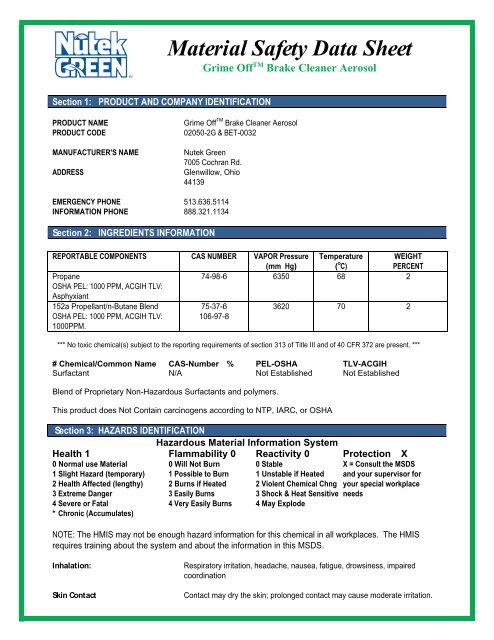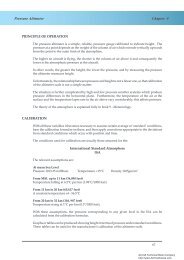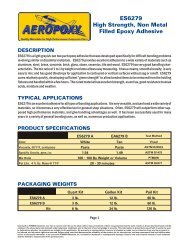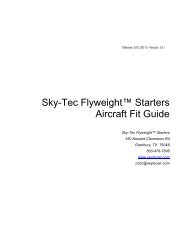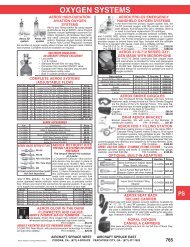Grime Off Brake Cleaner MSDS - Aircraft Spruce
Grime Off Brake Cleaner MSDS - Aircraft Spruce
Grime Off Brake Cleaner MSDS - Aircraft Spruce
Create successful ePaper yourself
Turn your PDF publications into a flip-book with our unique Google optimized e-Paper software.
Section 1: PRODUCT AND COMPANY IDENTIFICATION<br />
PRODUCT NAME<br />
PRODUCT CODE<br />
MANUFACTURER'S NAME<br />
ADDRESS<br />
EMERGENCY PHONE<br />
INFORMATION PHONE<br />
<strong>Grime</strong> <strong>Off</strong> TM<br />
<strong>Brake</strong> <strong>Cleaner</strong> Aerosol<br />
02050-2G & BET-0032<br />
Nutek Green<br />
7005 Cochran Rd.<br />
Glenwillow, Ohio<br />
44139<br />
513.636.5114<br />
888.321.1134<br />
Section 2: INGREDIENTS INFORMATION<br />
REPORTABLE COMPONENTS<br />
Propane<br />
OSHA PEL: 1000 PPM, ACGIH TLV:<br />
Asphyxiant<br />
152a Propellant/n-Butane Blend<br />
OSHA PEL: 1000 PPM, ACGIH TLV:<br />
1000PPM.<br />
CAS NUMBER<br />
74-98-6<br />
75-37-6<br />
106-97-8<br />
VAPOR Pressure<br />
(mm Hg)<br />
6350<br />
3620<br />
Temperature<br />
( o C)<br />
68<br />
70<br />
WEIGHT<br />
PERCENT<br />
2<br />
*** No toxic chemical(s) subject to the reporting requirements of section 313 of Title III and of 40 CFR 372 are present. ***<br />
# Chemical/Common Name CAS-Number % PEL-OSHA TLV-ACGIH<br />
Surfactant N/A Not Established Not Established<br />
Blend of Proprietary Non-Hazardous Surfactants and polymers.<br />
This product does Not Contain carcinogens according to NTP, IARC, or OSHA<br />
.Section 3: HAZARDS IDENTIFICATION<br />
Hazardous Material Information System<br />
Health 1 Flammability 0 Reactivity 0 Protection X<br />
0 Normal use Material 0 Will Not Burn 0 Stable X = Consult the <strong>MSDS</strong><br />
1 Slight Hazard (temporary) 1 Possible to Burn 1 Unstable if Heated and your supervisor for<br />
2 Health Affected (lengthy) 2 Burns if Heated 2 Violent Chemical Chng your special workplace<br />
3 Extreme Danger 3 Easily Burns 3 Shock & Heat Sensitive needs<br />
4 Severe or Fatal 4 Very Easily Burns 4 May Explode<br />
* Chronic (Accumulates)<br />
NOTE: The HMIS may not be enough hazard information for this chemical in all workplaces. The HMIS<br />
requires training about the system and about the information in this <strong>MSDS</strong>.<br />
Inhalation:<br />
Skin Contact<br />
Material Safety Data Sheet<br />
<strong>Grime</strong> <strong>Off</strong> TM <strong>Brake</strong> <strong>Cleaner</strong> Aerosol<br />
Respiratory irritation, headache, nausea, fatigue, drowsiness, impaired<br />
coordination<br />
Contact may dry the skin; prolonged contact may cause moderate irritation.<br />
2
Skin Absorption<br />
Eye Contact<br />
Ingestion<br />
Health Hazards (Acute and<br />
Chronic)<br />
Carcinogenicity:<br />
IARC Monographs:<br />
OSHA Regulated<br />
Medical Conditions Generally<br />
Aggravated by Exposure<br />
Section 4: FIRST AID MEASURES<br />
Inhalation:<br />
Skin:<br />
Eyes:<br />
Section 5: FIRE FIGHTING MEASURES<br />
Can be absorbed. Solvent action can dry and defat the skin, causing the skin<br />
to crack, leading to dermatitis.<br />
Liquid or vapor can cause moderate to severe irritation.<br />
Not a likely route of exposure. If swallowed, seek immediate medical advice<br />
and/or attention. Do not induce vomiting.<br />
Acute: Eye irritant. Skin irritant. Chronic: None Known.<br />
NTP Carcinogen: No<br />
No<br />
No<br />
None Known<br />
FLASH POINT: 156 deg F METHOD USED: Estimated<br />
FLAMMABLE LIMITS IN AIR BY VOLUME: LOWER: 1.9 UPPER: 9.5<br />
Remove to fresh air. Administer oxygen if needed. Apply artificial respiration<br />
if breathing has stopped. Get medical attention.<br />
Wipe off with towel. Wash with soap and water. Get medical attention if<br />
irritation persists.<br />
Wash immediately with large volumes of fresh water for at least 15 minutes.<br />
Get medical attention.<br />
EXTINGUISHING MEDIA: FOAM, ALCOHOL FOAM, CO2, DRY CHEMICAL, WATER FOG<br />
SPECIAL FIREFIGHTING PROCEDURES<br />
Water spray may be ineffective. Water may be used to cool containers to prevent pressure build-up and explosion<br />
when exposed to extreme heat. If water is used, fog nozzles preferred. Wear goggles and self-contained breathing<br />
apparatus.<br />
UNUSUAL FIRE AND EXPLOSION HAZARDS<br />
Closed containers may explode from internal pressure build-up when exposed to extreme heat and discharge<br />
contents. Liquid of container will not support combustion. Over-exposure to decomposition products may cause a<br />
health hazard. Symptoms may not be readily apparent. Obtain medical attention.<br />
Section 6: ACCIDENTAL RELEASE MEASURES<br />
STEPS TO BE TAKEN IN CASE MATERIAL IS RELEASED OR SPILLED<br />
Avoid breathing vapors. Ventilate area. Remove all sources of ignition. Clean up area with absorbent material and<br />
place in closed containers for disposal.<br />
Section 7: HANDLING AND STORAGE<br />
Handling:<br />
Do not puncture or incinerate (burn) cans. Do not stick pin, nail or any other<br />
sharp object into opening on top of can. Do not spray in eyes. See product<br />
label for additional information.
Storage:<br />
Section 8: EXPOSURE CONTROL/PERSONAL PROTECTION<br />
Store and use in cool, dry, well-ventilated areas. Do not store above 120<br />
degrees Fahrenheit.<br />
PRECAUTIONS<br />
The storage of non flammable products with non flammable or flammable pressurizing agents, in cartons, is the same<br />
as for ordinary canned goods in cartons. .<br />
RESPIRATORY PROTECTION<br />
None under normal use. Avoid breathing vapors. In restricted areas, use approved chemical/mechanical filters<br />
designed to remove a combination of particles and vapor. In confined areas, use approved air line type respirator or<br />
hood.<br />
VENTILATION<br />
Sufficient to prevent inhalation of solvent vapors. General dilution and/or local exhaust ventilation in volume or<br />
pattern to keep PEL/TLV of most hazardous ingredient below acceptable limit and LEL below stated limit.<br />
PROTECTIVE GLOVES<br />
None under normal use. Solvent resistant gloves required for prolonged or repeated contact.<br />
EYE PROTECTION<br />
None under normal use, however use of safety glasses with splash guards or full face shield is recommended.<br />
OTHER PROTECTIVE CLOTHING OR EQUIPMENT<br />
None under normal use; however use of solvent resistant aprons or other clothing is recommended..<br />
WORK/ HYGIENIC PRACTICES<br />
Eye washes and safety showers in the workplace are recommended.<br />
Section 9: PHYSICAL AND CHEMICAL PROPERTIES<br />
BOILING RANGE: 212 o F SPECIFIC GRAVITY (H2O=1): 1.0<br />
VAPOR DENSITY: Unknown EVAPORATION RATE: Unknown<br />
SOLUBILITY IN WATER: Complete pH: 9.0<br />
APPEARANCE AND ODOR: AEROSOL PRODUCT<br />
Section 10: STABILITY AND REACTIVITY<br />
STABILITY: Stable<br />
CONDITIONS TO AVOID:<br />
Application to hot surfaces. Storage above 120 Degrees Fahrenheit. Exposure to open flame.<br />
INCOMPATIBILITY (MATERIALS TO AVOID):<br />
Oxidizing agents.<br />
HAZARDOUS DECOMPOSITION OR BYPRODUCTS:<br />
May produce fumes when heated to decomposition. Fumes may contain carbon monoxide.<br />
HAZARDOUS POLYMERIZATION:<br />
Will not occur.
Section 11: TOXICOLOGICAL INFORMATION<br />
Long-term toxicological studies have not been conducted for this product.<br />
Section 12: ECOLOGICAL INFORMATION<br />
Long-term ecological studies have not been conducted for this product.<br />
Section 13: DISPOSAL CONSIDERATIONS<br />
Dispose of in accordance with local, state and federal regulations. Before attempting to clean up, refer to other<br />
sections of this <strong>MSDS</strong> for hazard caution information.<br />
Section 14: TRANSPORT INFORMATION<br />
By Land:<br />
By Water:<br />
By Air:<br />
Section 15: REGULATORY INFORMATION<br />
DOT PROPER SHIPPING NAME: CONSUMER COMMODITY, ORM-D<br />
DOT PROPER SHIPPING NAME: UN 1950, Aerosols, 2.1, LTD QTY<br />
DOT PROPER SHIPPING NAME: UN1950, Aerosols, flammable, 2.1, LTD QTY<br />
(Packing instruction Y203 applies)<br />
PRODUCT AS WHOLE All ingredients are either listed on the TSCA inventory or are exempt.<br />
ACGIH<br />
AIHA<br />
ANSI<br />
Canada – DSL<br />
CFC<br />
EINECS<br />
EU Risk phrase #’s<br />
FDA-21 CFR 174.5<br />
Section 16: OTHER INFORMATION<br />
DATE PRINTED: 08/26/11 NAME OF PREPARER: RY - DH<br />
HMIS CODES: H-1 F-0 R-0 P-X<br />
CAUTION: Intentional misuse of this chemical product, as with any industrial chemical in contact with the body, can<br />
be harmful or fatal. This includes such things as deliberately breathing , placing in mouth, swallowing, placing on<br />
skin, or any other contact, or repeated or continuous contact.<br />
Nutek Green provides this information in good faith, but makes no representation as to its comprehensiveness or<br />
its accuracy. This document is offered as a guide to a trained person for appropriate precautionary handling.<br />
Persons using the product and receiving the information must exercise independent judgment in determining the<br />
appropriateness of the use and safety information for their particular purpose.<br />
NUTEK GREEN MAKES NO REPRESENTATIONS WRITTEN OR WARRANTIES, EXPRESSED OR IMPLIED, INCLUDING<br />
WITHOUT LIMITATION ANY WARRANTIES OF MERCHANTABILITY OR FITNESS FOR A PARTICULAR PURPOSE WITH<br />
RESPECT TO THIS INFORMATION OR TO THE PRODUCT. ACCORDINGLY TTI WILL NOT BE RESPONSIBLE FOR<br />
DAMAGES RESULTING FROM USE OF OR RELIANCE ON THIS INFORMATION.<br />
ACGIH American Conference of Governmental Hygienists<br />
AKA Also Known As. Synonym


